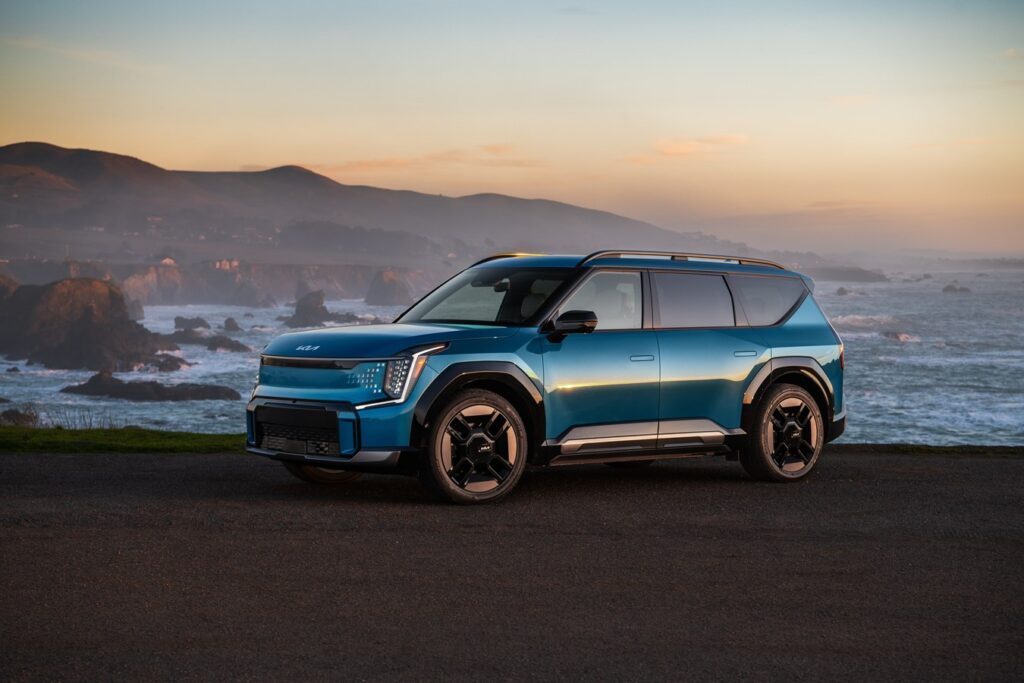With the recent debut of Kia’s new EV3 compact crossover, Kia continues to flesh out their EV crossover lineup. Along with EV6, EV9, and EV5, they’ve established an EV lineup playing in nearly every key crossover segment: subcompact (3), compact (5), mid-size (6) and three-row (9). The simplistic model names may not evoke any adventurous destinations, but they do follow an easy-to-understand logic. And, perhaps more importantly, they all share the same E-GMP platform, allowing Kia to capitalize on economies of scale and efficiencies in development and production.
Visually, the EV3 shares its design DNA with the large EV9, while the EV6 delivers a sportier and perhaps more avant-garde personality. Whether you love the design of these new models or not, it’s clear that they’re effectively establishing a strong identity, complete with a progressive brand image and distinct design language. Kia’s design language and technical benchmarks are effectively conveying values like innovation, efficiency, progressive tech, leveraging distinctive features like their cutting-edge lighting and mold-breaking design elements to do so.
I think it’s fair to say that Kia has delivered a master class in product and brand development, not to mention an utterly impressive demonstration of the Korean conglomerate’s industrial prowess, launching not just a series of all-new models, but a coherent portfolio of well-sorted new products that continue to propel Kia from its once-lowly status as a discount brand to it’s newly staked-out territory as a desirable and exciting car to own.
This achievement is not solely a byproduct of their EVs. Kia has been producing hits for years. The Telluride is the most impressive example of their recent product and market successes, but far from their only hit. Most impressively, the rollout of their all-new EV lineup has been so methodical and thus far free of any public hiccups, strategic errors, or misfires. Just a well-oiled machine turning out well-reviewed and strong-selling new models in the most interesting new period of change in the automotive industry in 100 years.
Meanwhile, rivals – both legacy makers (like GM, Ford, and Toyota) and upstarts (like Tesla, Lucid, and Polestar) are all experiencing painful hardships in their respective quests to successfully navigate this massive shift, managing major changes in R&D investments, engineering, manufacturing, battery development, and chips, all while racing to become profitable in a brutal, cutthroat environment.
Kia’s sister brand Hyundai also appears to be humming along in their EV endeavors, obviously not a coincidence as the E-GMP platform is a shared resource. Hyundai, though, has a slightly longer track record of success, at least in the US, and so their EV triumphs are less of a revelation. The key takeaway here is that together Kia and Hyundai are setting themselves up to utilize the EV transition greatly to their advantage. Long-term thinking, critical strategic platform and battery investments, and a series of successful product launches in new segments are paying off and have established a formidable beachhead for Kia and Hyundai. We’re still in the early days of this transition, but the impacts of their efforts so far will be paying off for years to come.
Other automakers would be wise to learn from Kia’s savvy execution in this high-risk, high-reward new era. The Japanese automakers and Ford, in particular, seem to be struggling to find their way. While Ford has launched a handful of EVs globally, they have no platform strategy and apparently the company is currently scrambling to revise their approach away from large and expensive models to low-cost, high-volume segments. The Mach-E and F-150 Lightning have been well received but Ford is losing money with every sale. And because of their architecture (the Lightning is a modified F-150 and the Mach-E is built on a bespoke chassis derived from the Escape), they lack the segment penetration and economies of scale that competitors like Kia (E-GMP) and GM (Ultium) are aiming for with platforms that can accommodate models across numerous sizes, segments, brands, battery sizes, and motor powertrain setups. Even Lucid, with their highly regarded Air luxury sedan, needed to develop a second architecture for their upcoming Gravity SUV, and will need a third architecture for their subsequent mid-size models.
Kia, thanks to their stellar planning and execution, appears poised to make a ton of conquest sales over the coming years with their fresh, competitive, and compelling EV offerings. It will be interesting to see how the competition responds to their impressive product offensive.



